Part II
3 Epidemiology of Infectious Diseases
Learning Objectives
By the end of this chapter the reader will be able to:
- Learn about the field of infectious diseases as the initial field of study in epidemiology
- Learn about the epidemiological triangle and its related terms commonly used in the area of infectious diseases
- Relate prevention of disease outbreaks to modes of transmission
- Analyze the concepts of infectivity, pathogenicity, incubation period
- Apply the learned concepts to real life situations, especially during epidemics
Introduction
How do things get started?
Everything started with the epidemiologic triangle and its components – already covered at the beginning of this book. I am posting the image again to refresh the concept. See below:
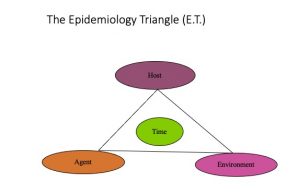
It is accepted that the agent is one of the major factors, without an agent there is no disease [because this is a biological/medical model]. Common agents include bacteria, viruses, fungi, other microbes, and parasites.[3], [4] Examples of common agents include, viruses. See picture below:
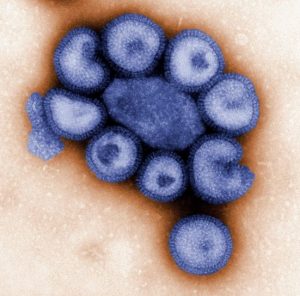 |
| Electronic picture of a virus. Photo by Judy Schmidt, Image from PIXNIO. Public Domain. |
The host
The host can be a person or an animal that harbors the disease. [5] As described later in the textbook, a host can show symptoms of the disease, or can be free of symptoms. Also, the host may or not get the disease.
The environment
Disease Transmission
Common ways of transmission
Transmission goes together with the concept of the chain of infection [also visited before in this book]. See the image below about the general process of transmission.
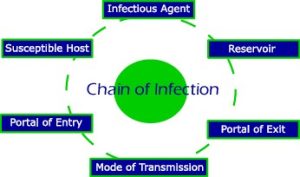 |
In this context, diseases can be transmitted directly or, indirectly. Direct transmission is the spread of disease from person to person. Examples, kissing, touching an infected person (or, the person who has the disease). It can occur through direct physical contact, or direct person-to-person contact, such as touching with contaminated hands, skin-to-skin contact, kissing, or sexual intercourse. In other situations, the direct transmission occurs while a person is coughing or, sneezing in which the droplets (of infection) spread from an infected person to a susceptible host[7]
Indirect Transmission, in this case, the spread of the infection occurs through an intermediate source called, vehicles, fomites, or, vectors. These terms require the use of some definitions starting with vehicle, which is the medium that contains the infection agent. Examples of vehicles include used needles contaminated with blood, which is common among IV substance users, or, in the case of needles accidentally contaminated with hepatitis. Another common example of a vehicle is contaminated water.
|
|
| Image Source: Indian Journal of Health Sciences and Biomedical Research KLEU and Pinterest |
Other forms of Indirect transmission, airborne, in this situation, the disease is spread via droplets when a person sneezes, coughs, or talks, spraying microscopic pathogens. It can also happens when dust particles are spread by fans in abandoned buildings.
 |
| ‘Airborne transmission,’ image from Wikimedia, Licensed CC BY 4.0 International. |
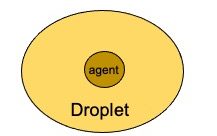 |
| ‘The Droplet nuclei’, Image prepared by Giovanni Antunez, Licensed CC BY 4.0 |
To have an idea of the generation of the mentioned droplets (including the droplet nuclei) it helps to compare how many of these droplets can be generating while coughing, talking, or, sneezing. See image and comments below:
|
|
| ‘Sneezing,’ image from CDC PHIL, Public Domain. |
Additional examples of Indirect transmission include, waterborne, vehicleborne, foodborne, and vectorborne diseases. Details of these forms of transmission are discussed in more detail below:
Waterborne, this type of indirect transmission is when a pathogen (for example, shigella or cholera) is carried via drinking water, swimming pools, streams, or lakes. This type of transmission is more frequent during some periods of the year, for example, summer when most people are more active and visit recreation centers that have public pools, or when people visit lakes.
 |
|
Shigella’ bacteria, image from Medicinenet.
|
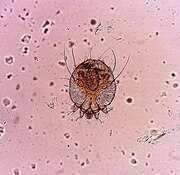 |
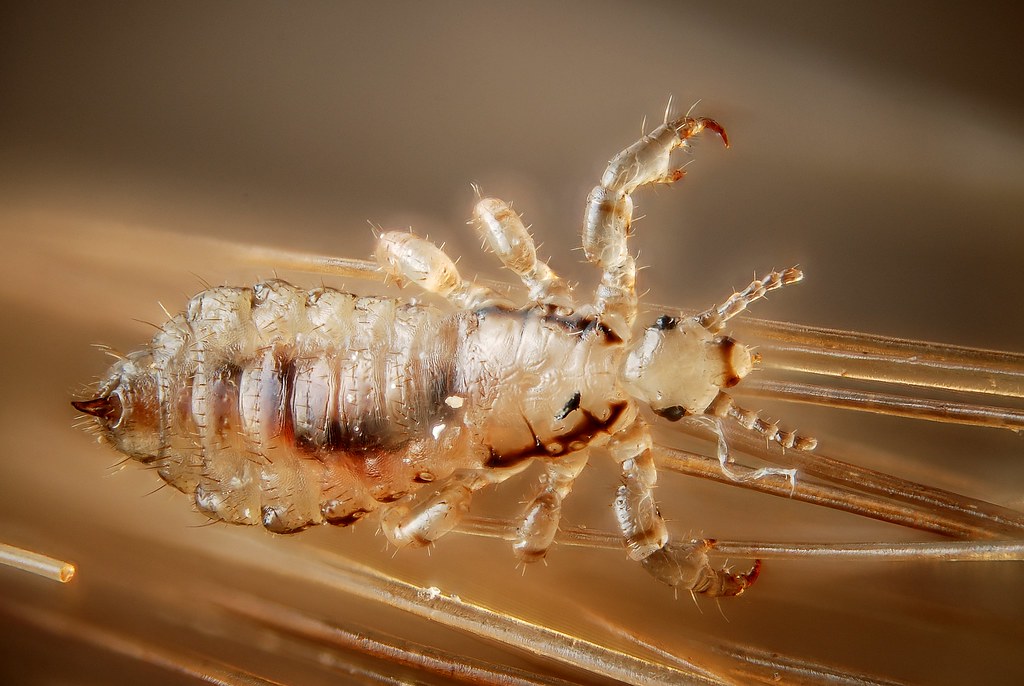 |
 |
| ‘Sarcoptes scabei’ image from Wikimedia. | ‘Pediculosis capitis‘, the cause of a head lice, image from Flickr. | ‘Pediculosis pubis’ the cause of Pubic lice, from Wikimedia. |
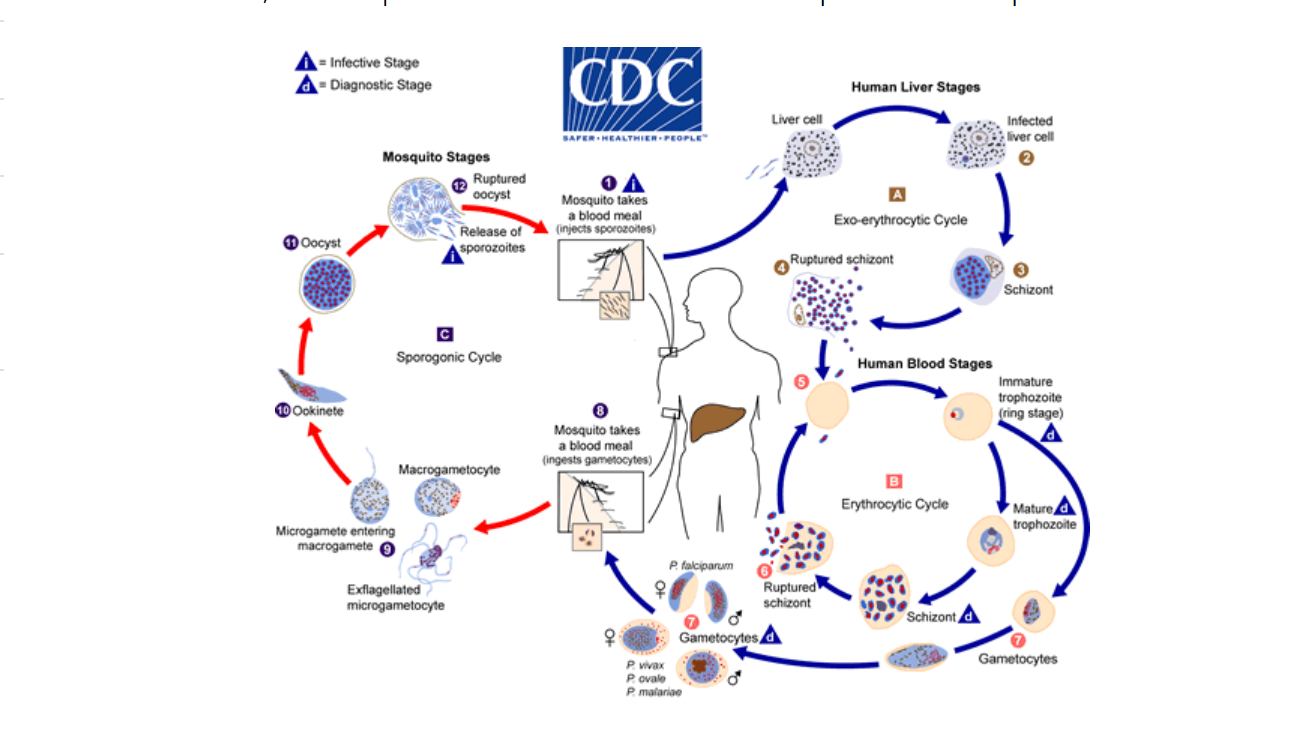 |
| ‘Malaria Cycle,’ Image from CDC, Public Domain. |
Reservoirs
This term refers to humans, animals, plants, soil, or inanimate organic matter (feces or food) in which infectious organisms live and multiply. For example, the reservoir for Clostridium tetani that causes tetanus is
/easy-diy-soil-tests-2539856-Hero-bd1da2df7d2a49ee8a1b5e701e628679.jpg) |
| ‘Soil’, image by Jayme Burrows at The Spruce. |
commonly contaminated soil. This information is very important, especially for individuals who do gardening or work in occupations that require handling of soil and have open wounds that could be contaminated with Clostridium spores. [11]
Fomite(s) which are inanimate objects that may become contaminated with the infectious agent. A common example is contaminated diapers in a daycare center. Diapers are also fomites that may contribute to the spread of some infectious agents, especially, gastrointestinal, and respiratory infections. [12]
 |
| Image from Diapers. |
Another example is personal protective equipment (PPE) used for decontamination. Although fomites seem important in the transmission and spread of infectious disease, fomites are not effective (they do not always contribute) to the transmission of disease.
The last of the terms in the topic of indirect transmission is vectors, it refers usually to insects and small animals that contribute to the spread of disease as part of their life cycle. Common examples of vectors are fleas, mites, flies, mosquitoes, small rodents, etc. These vectors contribute to the spread of disease in an effective manner, so, their control is part of the preventive measures of well-known infectious diseases such as malaria, Zika virus, West Nile virus, and others.
 |
| Common Disease Vector, the mosquito that transmit malaria, image from Wikimedia, Public Domain. |
 |
| Image “Examples of Zoonotic Diseases and Their Affected Populations,” Wikimedia Commons, Licensed Public Domain. |
Zoonosis, when an animal transmits the disease to a human. Examples of this type of disease include malaria, lice, tinea, dengue fever, and others.
There is also, the term Zoonoses, those diseases and infectious transmitted between vertebrate animals and man (or, humans). Examples include mad cow disease, equine meningitis, cryptosporidium, hantavirus, toxoplasmosis, rabies, and others.
Enzootic, this term is not commonly used, and it refers to a disease that only affects animals, a small number of them, and in a persistent manner (or, endemic).
These diseases that are transmitted from animals to humans, or, from one animal to another represent a significant source of morbidity and mortality, not only for humans but also for animals, which also makes a public health that concerns other areas of public health and medicine such as it is veterinary medicine. It has been mentioned also that new epidemics in the world would be linked to diseases in animals or, zoonotic diseases. [13]
The concept of carriers
Carrier, is the process that can contribute to the spread of disease. A carrier contains, spreads, or harbors an infectious organism. It is accepted that there are at least six types of carriers: active, convalescent, healthy, incubatory, intermittent, and passive. Some of them will be defined as follows:
Convalescent carrier, in this case, the term refers to an individual who has been exposed to and harbors a disease-causing organism (pathogen), it is in the recovery phase of the course of the disease but is still infectious. An example of this is a person recently diagnosed with COVID-19 who is in the recovery phase with no symptoms but for whom the blood test shows that the person is still infectious.
Healthy carrier, the situation refers to an individual who has been exposed to and harbors a disease-causing organism (pathogen) but has not become ill or has not shown any of the symptoms of the disease. An example of this is, the prevalence of healthy carriers of N. meningitidis in an unvaccinated population with high serum titles of the pathogen but asymptomatic.
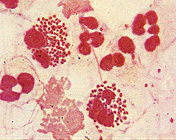 |
|
“An electronic picture (microscopic) of N. Menigiditis, ‘ Image from Blogspot.
|
Intermittent carrier, this is when an individual or, animal, has been exposed to and harbors a disease-causing organism (pathogen), and who can intermittently spread the disease at different places or intervals. Examples, chronic salmonellosis (S. typhi/enterica) in humans and animals (reptiles, exotic pets, and cattle). The humans or animals shed the salmonella bacteria in their feces, and if persons with this problem don’t wash their hands after defecation, the disease can spread to others, as is the case, of cooks who cook and serve food for others. For this reason, it is a public health measure to regularly check people working in the food industry, especially cooks for salmonellosis, so, the intermittent or chronic carrier does not infect passively other people. [14]
 |
| ‘Geographical distribution of typhoid fever,’ Image published in Lancet, but originally developed by the World Health Organization, Public Domain. |
How an infectious agent entries in the body
Other information that is commonly covered in the principles of epidemiology textbook is the concepts of how disease enters to the body or, organism and how it leaves (or, exits) the host; this is known as, Portals of Exit and Entry of infectious diseases. Most books and similar offer complex tables of information that can be found elsewhere, [15], [16], [17] but the following image should summarize what most student need to know for a principles of epidemiology textbook. I developed the following slide using a mnemonic that will assist with remembering the main portals, the mnemonic is COCONUT.
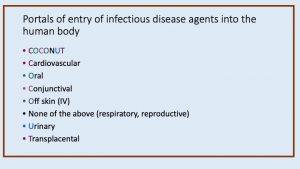 |
| Image prepared by Giovanni Antunez, Licensed CC BY 4.0 |
Some of the entrances for disease in an organism, or, host are more effective than others, for example, blood (Intravenous, or, trans-placental) is probably the most efficient, followed by inhalation and oral.
There are other definitions (or, terms) that are related to the concept of disease transmission, the most important will be reviewed. These are the incubation period, inapparent infection, generation time, and herd immunity.
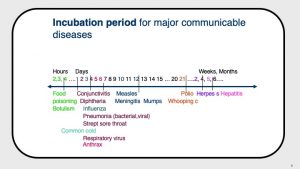 |
| Image prepared by Giovanni Antunez, Licensed CC BY 4.0 |
As seen in the image, some infectious diseases have a short incubation period while for others, it may take months, and years to manifest. In the case of food contamination (commonly called, food poisoning), the incubation period is a matter of hours, and depending on the infectious agent, the severity of the disease may lead to dehydration, complications, or even death. Another example of a short incubation period is the common cold, the person exposed (and contaminated) to the infection may start the symptoms as early as 12-24 hours after exposure.
Inapparent infection, is a concept that has clinical significance because it refers to asymptomatic persons who have the disease, but its condition has not reached the level to be clinically obvious (with symptoms). With the advent of COVID-19, this category has raised attention because asymptomatic individuals can transmit the disease to other susceptible hosts. These individuals with no symptoms can be unknown carriers. [18]
Another way to see the process described above is presented in the image below:
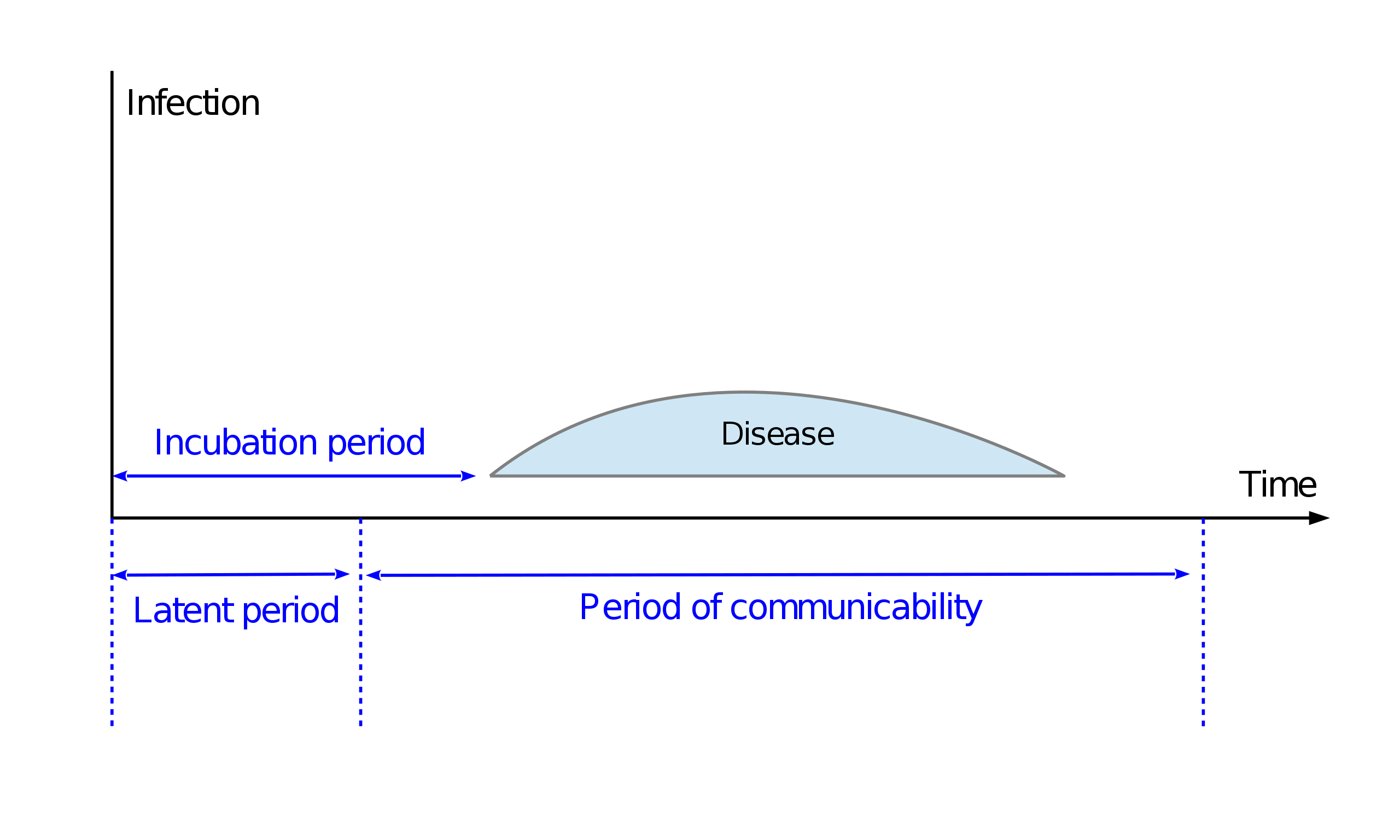 |
| ‘Concept of Incubation period,’ image from Wikimedia, Licensed CCO 1.0 Public Domain. |
Herd immunity
In general and for those of us whose English is a second language, the word ‘herd’ can be confusing, but one way to understand its usage is when we refer to groups of sheep, cattle, or any other ‘herd’ that needs protection (from the wolf, or, the possum). So, the word 'herd' is mostly synonymous with protection. In simple terms, herd immunity refers to the percentage of people or, animals that can be protected by immunization. The higher the number of immunized individuals, the higher the protection for those who are not immunized. In the past, this concept was highly regarded, and it was the belief that with at least 70% of vaccinated individuals, the protection was accomplished. But over the years, and with the advent of so many infectious diseases (old, and new), there is some consensus that the number should be at least 95% (the number varies by disease) of vaccinated to get herd immunity for those who are not immunized. [19],[20],[21],[22]
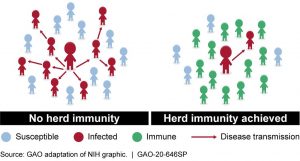 |
| ‘A graphic representation of the concept of herd immunity’, This image is excerpted from a U.S. GAO report. |
It is important to mention that herd immunity does not work for all infectious diseases, that is another reason for the concept to be considered a ‘weak’ and ‘old’ concept to refer to this method (vaccination) used to control the spread of an infectious disease. Maybe the key is to add to the vaccination other effective features that have been used in public health for centuries, good sanitation, soap and water to wash hands and other surfaces, mask covering and social distance among other measures that we have seen working during the COVID-19 pandemic.[23].
Methods commonly used to prevent and control infectious diseases (also, called, communicable diseases)
The following section will cover the essential methods used commonly to prevent an infectious disease, it starts with the use of vaccines, sanitation, isolation, quarantine, and additional measures that have been used for centuries but are becoming relevant these days with the COVID-19 pandemic. In addition, there are three key factors that are considered essential, 1) Remove, eliminate, or contain the cause or source of infection, 2) Disrupt and block the chain of disease transmission, and 3) Protect the susceptible population against infection and disease. In this context, an additional set of recommendations is also prescribed, and discussed in the following paragraphs:
Vaccines (also, called, Immunizations)
In the history of medicine and public health (including, epidemiology), vaccines have been considered the major weapons of defense, especially in the prevention of infectious diseases, especially those common childhood infectious diseases. [24] See below a list of common vaccines that are available:
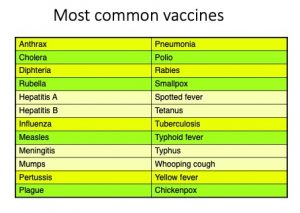 |
| Image prepared by Giovanni Antunez, Licensed CC BY 4.0 |
 |
| Image from how vaccines work. |
Sanitation
Hand washing has been the oldest of the measures used to prevent infection. For centuries, public health has promoted hand washing as the number one activity to keep people out of disease (infectious disease).[27], [28]Together with this measure, it is important to pay attention to personal hygiene (frequent bathing, regular
 |
| ‘Hand washing’ image from Pixbay. |
grooming, teeth cleaning, and maintenance, changing clothes frequently), and to keep ventilation in homes, and buildings as the cleaning of surfaces that can act as Fomite(s) or, inanimate transmitters of an infectious agent.[29]
In addition, face mask covering and personal protective equipment or PPE are also considered
 |
| Family mask, image from Pixabay. |
especially for healthcare workers who are considered more at risk due to their exposure with infected clients, and surfaces.[30]
Environmental controls to prevent infectious diseases
This measure is aimed at providing clean and safe air, water, milk, and food. It also includes the management of solid waste (trash, and garbage); liquid waste (sewage); and control of vectors (insects and rodents) of disease.
Host-related control & prevention
Based on the concept model of the epidemiological triangle of infection, the host-related control is intended to protect the host from contagious diseases and infections the following protective measures are used: quarantine and isolation.
Quarantine
The original meaning of this word is that quarantine means, forty days, however in recent years, the word quarantine refers to specific amount of time considered in which a person is isolated, or, separated from those who are not infected with the agent, and it is not necessarily forty days, it can be as short a week, two weeks, depending on the situation as it has been used during the COVID-19 pandemic. [31], [32]
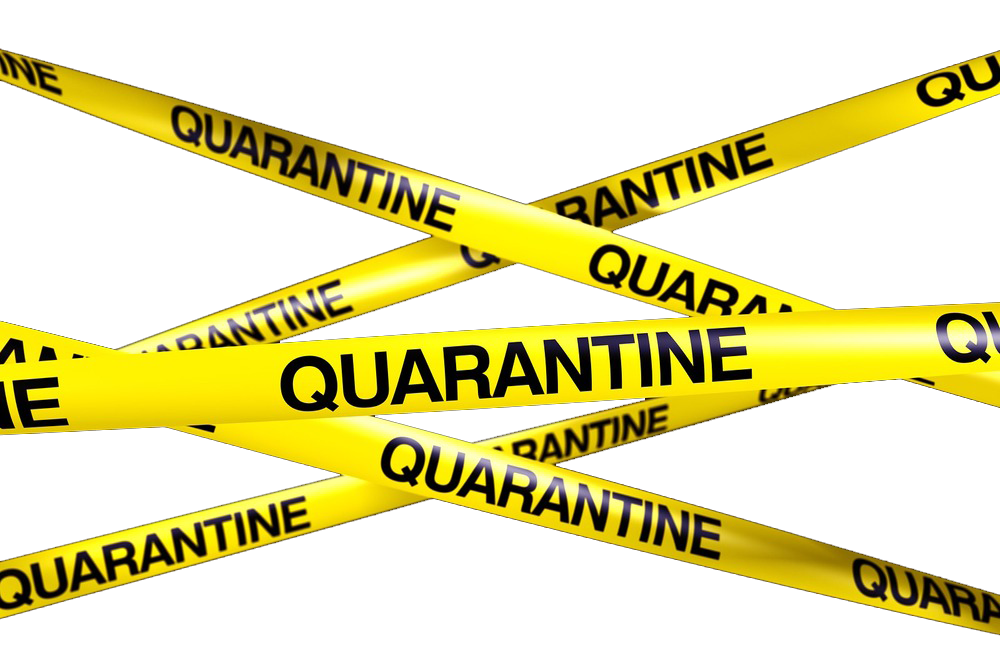 |
| ‘Quarantine’, image from PNGmart. |
In addition, it accepted that there are four levels of quarantine used in public health: 1) Segregation, 2) Personal surveillance, 3) Modified quarantine, 4) Complete quarantine. Most of the mentioned levels are very much self explanatory but more details can be found in the Internet and epidemiology and public health literature. [33]
Isolation
This method is mainly used for limited number of cases as it is in the case of humans, and also for animals. There are six levels of isolation: 1) In a private isolation room, 2) The use of separate and infection control gowns, 3) Staff must wear masks, 4) All staff must gloved with interacting, treating, or working
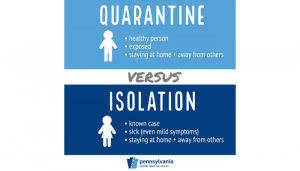 |
| ‘Quarantine versus isolation’, Image from Dept. of Health, City of Philadelphia, Pennsylvania. |
with or on the patient or subject (e.g. an animal), 5) Hands washing is required upon entering, and leaving the patient’s room, 6) All contaminated articles or possible contaminated articles including linen, dressing, syringes, instruments, etc., must be disposed properly.[34]
Summary
- Barreto, M. L., Teixeira, M. G., & Carmo, E. H. (2006). Infectious diseases epidemiology. Journal of epidemiology and community health, 60(3), 192–195. https://doi.org/10.1136/jech.2003.011593 ↵
- CDC. (n.d.). Lesson 1 Understanding the Epidemiologic Triangle through Infectious Disease, pdf material. From https://www.cdc.gov/healthyschools/bam/teachers/documents/epi_1_triangle.pdf ↵
- Mayo Clinic. (n.d.). Types of infectious agents. From https://www.mayoclinic.org/diseases-conditions/infectious-diseases/multimedia/types-of-infectious-agents/img-20008643 ↵
- Janeway, CA., Travers, P., Walport, M. et al. (2001). Immunobiology: The Immune System in Health and Disease. 5th edition. New York: Garland Science. Infectious agents and how they cause disease. From: https://www.ncbi.nlm.nih.gov/books/NBK27114/ ↵
- Bowden, S. E. & Drake, J. M. (2013) Ecology of multi-host pathogens of animals. Nature Education Knowledge 4(8):5. From https://www.nature.com/scitable/knowledge/library/ecology-of-multi-host-pathogens-of-animals-105288915/ ↵
- Gupta, A., Gupta, R., Singh, R.L. (2017). Microbes and Environment. In: Singh, R. (eds) Principles and Applications of Environmental Biotechnology for a Sustainable Future. Applied Environmental Science and Engineering for a Sustainable Future. Springer, Singapore. https://doi.org/10.1007/978-981-10-1866-4_3 ↵
- Valencia, H.V. (July 26, 2017). How Are Diseases Transmitted? Healthline. From https://www.healthline.com/health/disease-transmission ↵
- BC Ministry of Health. (n.d.). The Difference Between Droplet and Airborne Transmission From https://www.cda-adc.ca/_files/about/covid-19/The%20Difference%20Between%20Droplet%20and%20Airborne%20Transmission.pdf ↵
- Atkinson J, Chartier Y, Pessoa-Silva CL, et al. editors. (2009). Natural Ventilation for Infection Control in Health-Care Settings. Geneva: World Health Organization. Annex C, Respiratory droplets. From: https://www.ncbi.nlm.nih.gov/books/NBK143281/ ↵
- Tang, J. W., Li, Y., Eames, I., Chan, P. K., & Ridgway, G. L. (2006). Factors involved in the aerosol transmission of infection and control of ventilation in healthcare premises. The Journal of hospital infection, 64(2), 100–114. https://doi.org/10.1016/j.jhin.2006.05.022 ↵
- George EK, De Jesus O, Vivekanandan R. (2022, Jan). Clostridium Tetani. [Updated 2021 Aug 30]. In: StatPearls [Internet]. Treasure Island (FL): StatPearls Publishing. From https://www.ncbi.nlm.nih.gov/books/NBK482484/ ↵
- Boone, S. A., & Gerba, C. P. (2007). Significance of fomites in the spread of respiratory and enteric viral disease. Applied and environmental microbiology, 73(6), 1687–1696. https://doi.org/10.1128/AEM.02051-06 ↵
- Myrna E. Watanabe, M.E. (2008). Animal Reservoirs: Harboring the Next Pandemic, BioScience, 58, (8), 680–684. From https://doi.org/10.1641/B580803 ↵
- Gunn, J. S., Marshall, J. M., Baker, S., Dongol, S., Charles, R. C., & Ryan, E. T. (2014). Salmonella chronic carriage: epidemiology, diagnosis, and gallbladder persistence. Trends in microbiology, 22(11), 648–655. https://doi.org/10.1016/j.tim.2014.06.007 ↵
- BrainKart. (n.d.). Mode of Transmission In Chapter: 12th Nursing : Communicable Diseases. From https://www.brainkart.com/article/Mode-of-Transmission_37876/ ↵
- Al Sayyari, A. (n.d.). Patient Care In Medical Imaging RAD 233. Power Point presentation available at https://slideplayer.com/slide/6400979/ ↵
- No author. (n.d.). 3. Chain of Infection, page 3, PDF document available at https://www.gov.nu.ca/sites/default/files/files/3_%20%20Chain%20of%20Infection%20-%20march%205%20-%20low%20res.pdf ↵
- Syangtan G., Bista S., Dawadi P., Rayamajhee B., Shrestha LB., Tuladhar R., Joshi DR. (2021). Asymptomatic SARS-CoV-2 Carriers: A Systematic Review and Meta-Analysis. Frontiers in Public Health, 8, 1066. From https://www.frontiersin.org/article/10.3389/fpubh.2020.587374 ↵
- MacMillan, C. (May 21, 2021. Herd Immunity: Will We Ever Get There? From https://www.yalemedicine.org/news/herd-immunity ↵
- The Vaccine Knowledge Project. (n.d.). Herd immunity (Herd protection). From https://vk.ovg.ox.ac.uk/vk/herd-immunity ↵
- Dubé, E., Laberge, C., Guay, M., Bramadat, P., Roy, R., & Bettinger, J. (2013). Vaccine hesitancy: an overview. Human vaccines & immunotherapeutics, 9(8), 1763–1773. From https://www.ncbi.nlm.nih.gov/pmc/articles/PMC3906279/ ↵
- Association for Professionals in Infection Control and Epidemiology (APIC). (2021). Herd immunity. From https://apic.org/monthly_alerts/herd-immunity/ ↵
- D'Souza G., Dowdy, D. (September 13, 2021). Rethinking Herd Immunity and the Covid-19 Response End Game. Johns Hopkins University. From https://publichealth.jhu.edu/2021/what-is-herd-immunity-and-how-can-we-achieve-it-with-covid-19 ↵
- CDC. (n.d.). Vaccines for Your Children, Diseases & the Vaccines that Prevent Them. From https://www.cdc.gov/vaccines/parents/diseases/index.html ↵
- World Health Organization. (2020). How do vaccines work? From https://www.who.int/news-room/feature-stories/detail/how-do-vaccines-work ↵
- Excler, JL., Saville, M., Berkley, S. et al. (2021). Vaccine development for emerging infectious diseases. Nat Med 27, 591–600. From https://www.nature.com/articles/s41591-021-01301-0 ↵
- CDC. (no date). Show Me the Science - Why Wash Your Hands? From https://www.cdc.gov/handwashing/why-handwashing.html ↵
- Goldust, M., Abdelmaksoud, A., & Navarini, A. A. (2020). Hand disinfection in the combat against COVID-19. Journal of the European Academy of Dermatology and Venereology : JEADV, 34(9), e454–e455. https://doi.org/10.1111/jdv.16574 ↵
- CDC. (2022). How to Protect Yourself & Others. From https://www.cdc.gov/coronavirus/2019-ncov/prevent-getting-sick/prevention.html ↵
- Tabatabaeizadeh S. A. (2021). Airborne transmission of COVID-19 and the role of face mask to prevent it: a systematic review and meta-analysis. European journal of medical research, 26(1), 1. https://doi.org/10.1186/s40001-020-00475-6 ↵
- CDC. (no date). History of Quarantine. From https://www.cdc.gov/quarantine/historyquarantine.html ↵
- Kiliç, R., Ataman Hatipoğlu, Ç., & Güneş, C. (2020). Quarantine and its legal dimension. Turkish journal of medical sciences, 50(SI-1), 544–548. https://doi.org/10.3906/sag-2004-153 ↵
- CDC. (no date). Quarantine and Isolation. From https://www.cdc.gov/quarantine/index.html ↵
- CDC. (No date). Isolation. From https://www.cdc.gov/coronavirus/2019-ncov/your-health/quarantine-isolation.html#iso ↵
- Barbisch, D., Koenig, K. L., & Shih, F. Y. (2015). Is There a Case for Quarantine? Perspectives from SARS to Ebola. Disaster medicine and public health preparedness, 9(5), 547–553. https://doi.org/10.1017/dmp.2015.38 ↵
The term is used to identify the cause of the disease (a.k.a. ‘agent’
A person, or animal that harbors the disease.
the environment is everything that surrounds the host, or, promote the existence of the agent.
It refers to the duration of the disease, it includes incubation periods
The way in which disease can be transmitted.
the person who has the disease who may have symptoms or, not (as it is the case of carriers - defined later).
The circle that engulfs the agent, which is contained in the saliva or, any other fluid mainly from the respiratory system.
It is a host (person or animal) whose immune system is depressed, which makes the person or animal 'susceptible' to get the infection or disease. For example, a person with severe malnutrition.
Between the source of infection and the host
the medium that spreads the infectious agent
A disease transmitted by the air through for coughing.
Particles with 1-5 micron in diameter that contain (engulfed) an infection agent that is transmitted by air (airborne).
in this case, the spread of the infection occurs through an intermediate source called, vehicles, fomites, or, vectors.
Indirect transmission, the pathogen is transmitted by a vehicle (usually fomites) that include utensils, clothing, washing items, combs, etc.
Indirect transmission through a vector, for example, mosquitoes, ticks, etc.
it refers to inanimate objects that may be contaminated with the infectious agent
it refers usually to insects and small animals that contribute to the spread of disease,
Transmission of a disease from animals to humans.
The disease is transmitted between vertebrate animals and humans.
An endemic disease that affect a certain group of animals only.
a 'carrier' contains, spreads, or, harbors an infectious organism.
it refers to the way in which disease enters the body of the host, and left the host.
Individuals who have the disease but are asymptomatic.
individuals or, animals who carry/have the infectious agent but have no symptoms.
the time that takes an infectious disease to elevate at the level of case
A conventional term used to refer to the percentage of people or, animals that can be protected by immunization. The higher the number of immunized individuals, the higher the protection for those who are not immunized.
the word 'herd' is mostly synonymous of protection.
The chain of disease transmission is one of the models already discussed in this chapter.
The triangle elements include the host, the environment, and the agent. All of them in the 'time' dimension.
Common knowledge accept that the word quarantine derives from mid 17th century Italian word, quarantina ‘forty days’, from quaranta ‘forty’.

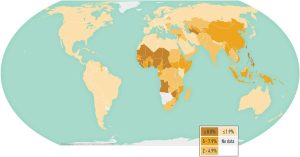

Feedback/Errata